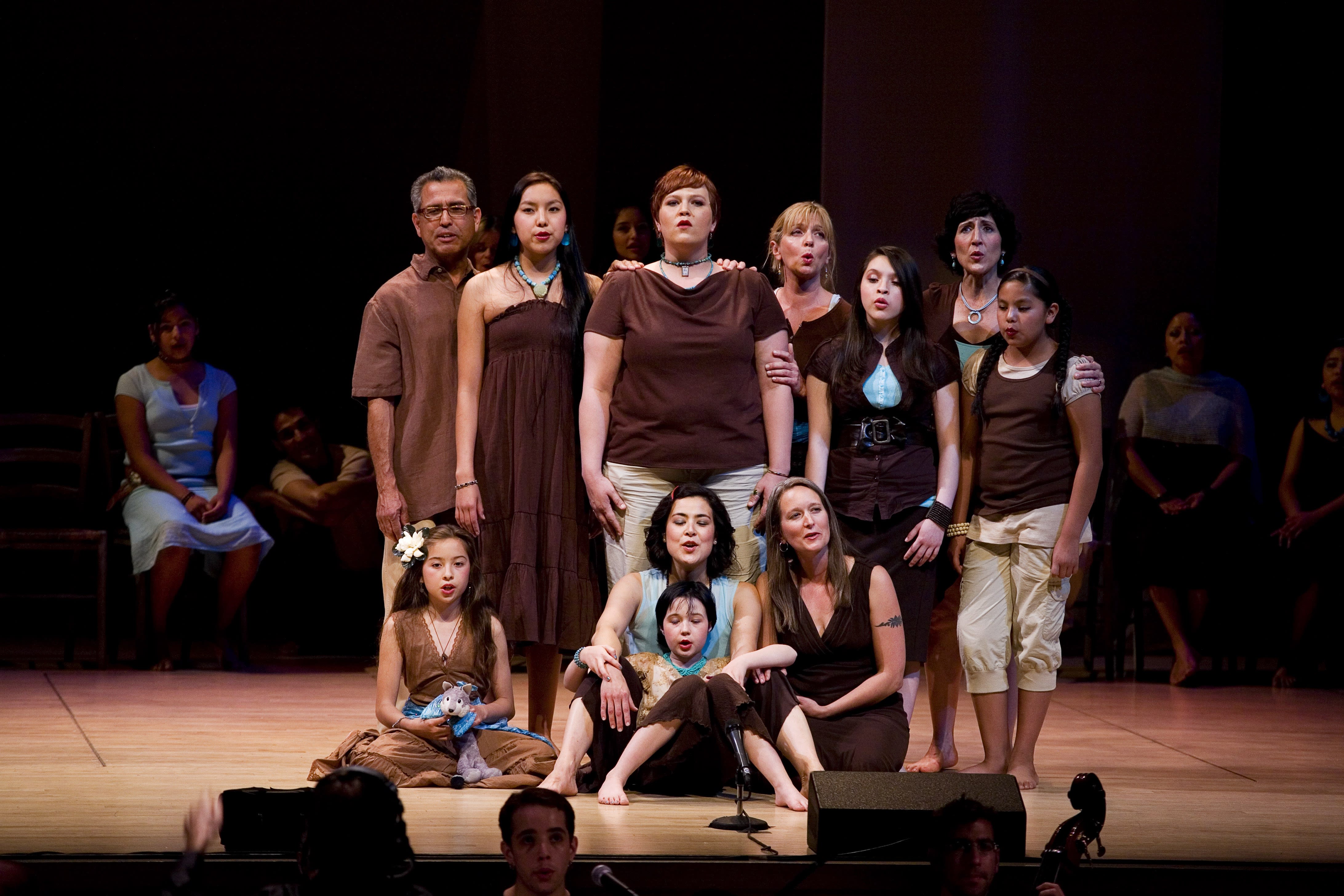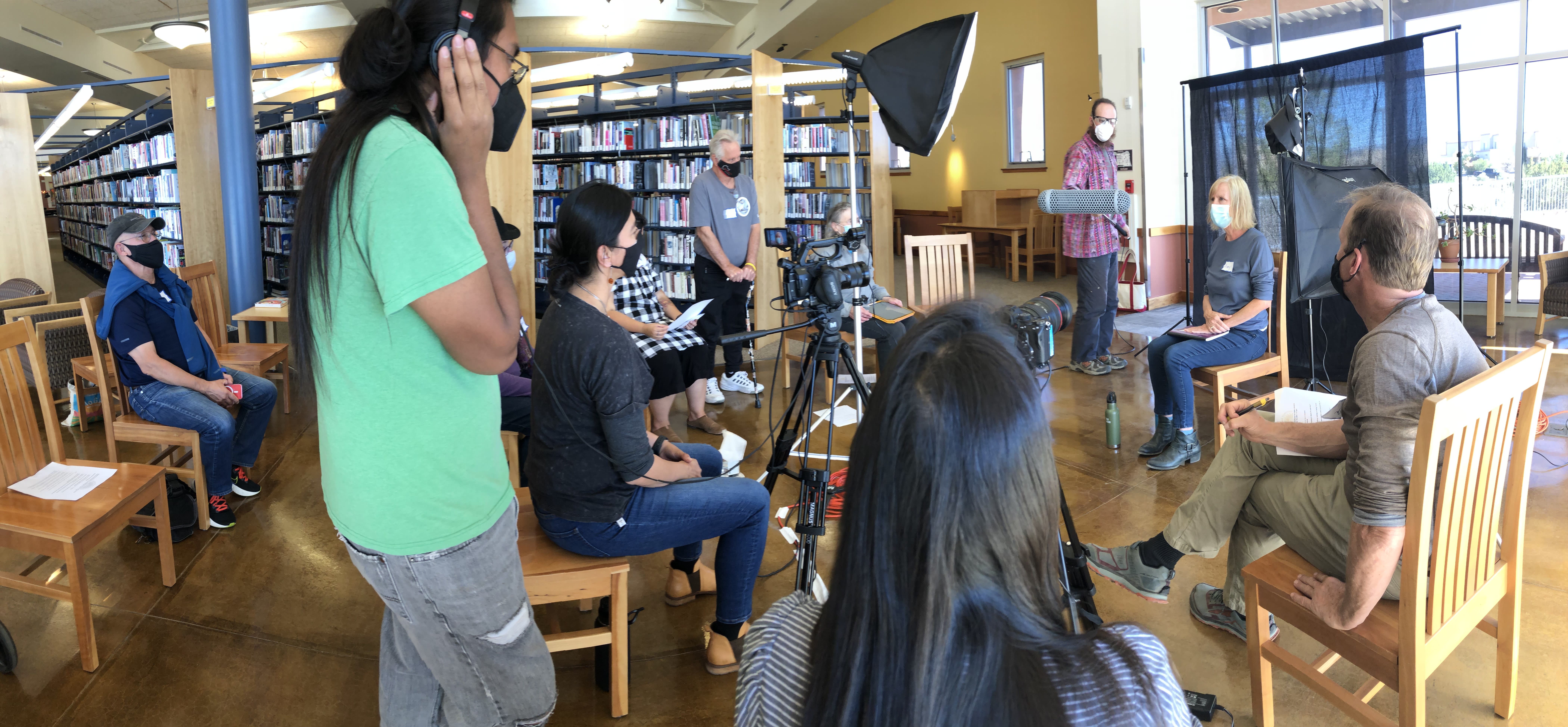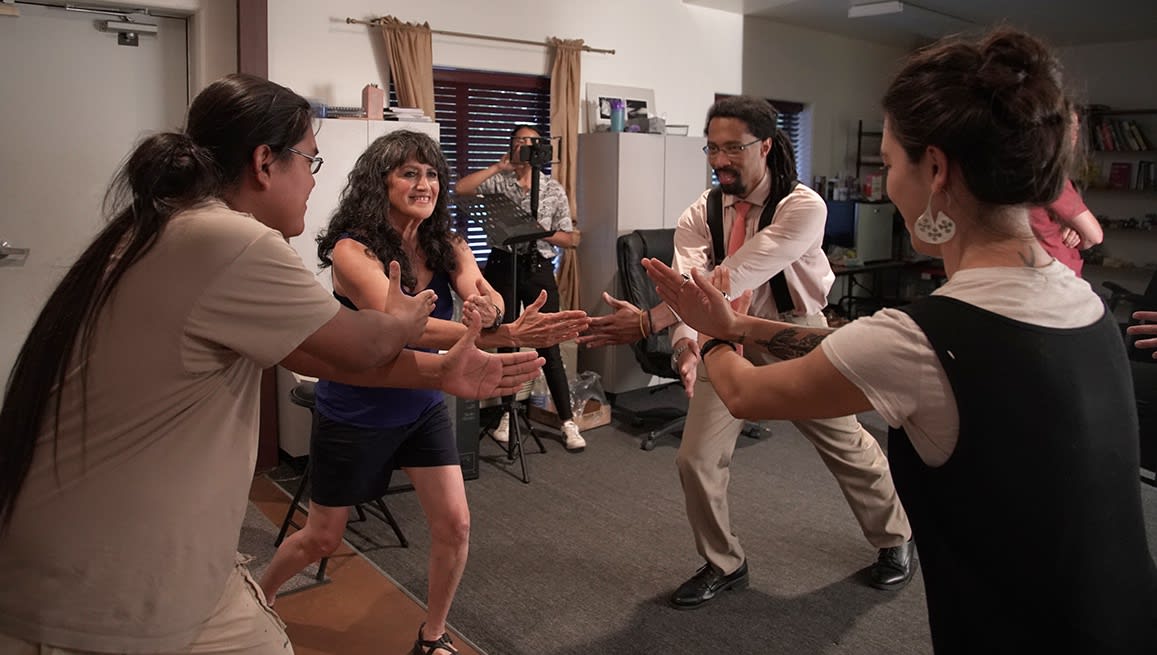
Out of all the organizations we've profiled in our Partners in Art series, Littleglobe is perhaps the most multifaceted. The nonprofit's lithe structure allows it to support local, national and international art projects simultaneously, with the overarching goal of bridging disparate individuals and communities.
Read on for an interview with Chris Jonas, Executive Director of Littleglobe, who cofounded the organization and has guided it through the ubiquitous "pandemic pivot." Please consider supporting Littleglobe through a donation on their website.

Dr. Estevan Rael-Galvez and Jesus Martinez, age 17, interviewing community members (2018) (photo by Katy Gross)
You are a cofounder of Littleglobe. What do remember about your early vision for the organization, and how has the organization evolved over time?
The underpinnings of Littleglobe's work came in the year 2000. My co-founder and partner at the time, Molly Sturges was asked to build a collaborative performance project with a group of women in NYC who were recent survivors of cancer. I was part of the team that provided video and support for the ensemble of women and multi-arts facilitators.
Together, the team of six artists and twelve participants built a multimedia framework to collaboratively bring to the surface stories, images, movement, video, music and spoken word and used those different media to co-author and share with an audience the complex felt experiences of living with cancer for the women involved. The resulting performance was experimental, freshly impactful and profoundly intimate.
This first project set a pattern of projects that continues to this day for Littleglobe: using a multi-arts set of tools to find access to stories that would otherwise be hard to tell using words alone - and by doing so, finding new pathways to empathically connect between ourselves human beings, inclusive of heartbreak, belonging, loss, love, and the most personal and subject aspects of our daily experiences living in this place during this time.
Littleglobe’s versatility as an organization is a bit mind-boggling at first glance. How do you describe its central mission, and the projects that branch out from that, to people who aren’t in the know?
Our mission is about using collaborative art making to bridge the boundaries that divide us, but it is our value statement that, for me, gives our work its power: Littleglobe believes that our communities thrive when all members are seen and heard.
As residents of Santa Fe and surrounding communities, it is imperative that we find means to feel and understand one another as we make decisions as a community. Our projects, such as Littleglobe TV and ¡Presente!: Stories of Home, Belonging and Displacement in Santa Fe both provide co-authored, multi-arts tools to explore the stories of Santa Fe as a grounding for the dialog about this town, seeing and feeling who lives here and determine together its future.
We do this through creative partnership with residents across Santa Fe, along with our long-term grassroots partners, schools and service providers who are part of our townspeople's daily lives. Through this, our storytellers and their stories are as complex as the town itself is, and the resulting projects are richly nuanced and personal.

Community ensemble performing Memorylines at the Lensic Performing Arts Center, 2007, a story-based commission by the Santa Fe Opera (photo by Kate Russell)
Your board of directors and operations staff has experience in so many sectors: film, law, medicine, social policy, human rights and, of course, nonprofits and the arts. Why is this broad array of knowledge bases important when it comes to forwarding your mission?
We believe that the work we do on the outside needs to start in-house. To do so, the circles of board and staff need to be of and from the diverse generations, perspectives, heritages and disciplines of Santa Fe. Increasingly, we are determined to dissolve the colonial roots of the outside-in nature of the non-profit, and to create the mechanisms and projects to have the stamina and flexibility for the much-needed hard conversations of our times, and work in co-authorship with our storytellers instead of the usual extractive ways that many "documentary" projects utilize.
You maintain a “core group” of artists who work with Littleglobe to spearhead large-scale projects and smaller collaborations. How do these artists end up in your orbit, and what qualities catch your eye when you’re seeking new collaborators?
Increasingly, those artists who resonate with Littleglobe's work find themselves walking through our front door, self-selectively joining our teams on an initial creative project, but over time our artists find their own place in Littleglobe. This happens by, yes, learning the tools, culture, and values that we have created over the years, but it also by adding their own perspectives and tools to Littleglobe and thereby changing us as an organization and team.
Our work is really about relationships - and how art making and storytelling creates new pathways to relationships. Our core value is a dialectic: Relationship Before Task AND Relationship Through Task.

Artists from the International Folk Art Market participating in a filmmaking workshop with Littleglobe instructors Katy Gross and Ash Haywood (photo by Chris Jonas)
Littleglobe’s work is largely episodic, with local, national and international art projects unfolding concurrently. What are some important common denominators between all of your projects?
I believe that one of the most important roles Littleglobe plays is through the providing of creative tools for people to tell their own stories, carrying the most intimate and granular of our experiences into the larger frame of identity, self-determinism and power in our world -- where the quietest voice in the room changes everything.
What are some active Littleglobe projects that you’re excited about right now?
We have four key projects underway right now. We are entering into a busy year of Littleglobe TV, our informal, hyper-local social media-based TV show, co-authoring a wide range of multi-arts Santa Fe stories with residents and community partners during the pandemic.
We are also early into the Neighborhood Historians project, training local residents to gather, archive and share a complex weave of stories of life in Santa Fe, current and past.
We are in the second year of bringing our story-based work to the arena of public policy through being part of the circle of nonprofits within the Midtown Engagement Partners, helping the City of Santa Fe to cultivate a local and equity-based lens to decision making about the development of that 64-acre site.
Finally, we are entering into the next phase of ¡Presente!, using a wide array of story-based programs to help this town grapple with the growing displacement crisis, a growing challenge in this increasingly expensive town.
In each of these projects, we are working with new and old partners, planning events such as broadcasts, block parties, school-based programs, trainings and ensembles, iterating approaches and frameworks, sharing power, and contributing our creative tools to our local community.

Neighborhood Historian Round Robin Workshop at the Santa Fe Public Library- Southside, October 2021 (photo by Chris Jonas)
How has the Covid-19 pandemic influenced Littleglobe’s work, especially when it comes to fostering inclusion by connecting disparate individuals and communities?
Like most other organizations and businesses, when the pandemic hit, we had to cancel most of the programs we had planned but we also went immediately to our key partners and spoke to them about what they needed and how we could help. Teachers in particular had to scramble to change their lessons to be online, and so we built the "Culture Connects Toolkit" and created a series of Zoom-based digital story workshops.
We also used the pause as an opportunity to look deeply at how we as an organization needed to change to be fully inside-out, non-extractive and driven by participatory leadership and partnership, and creating the Littleglobe Governance Council.
Our team is now more representative of the communities we serve and we have a more responsive set of programs which are adept at ensuring that our programs are of and from the people of this place, reflecting the complex weave of people that make up Santa Fe. Through this, Littleglobe feels like it is ready and capable to work with others to hold the hard conversations about the past, present and future of this place, grounded in the lives and stories of the people who live here.
Finally, how and why should folks support Littleglobe?
Littleglobe is always looking for community participation in our organization and projects. We believe that we each bring whatever we can to the conversation about who we are as a community. So certainly, join us and share the stories from your world and become a Littleglobe supporter or partner -- but most importantly, become an advocate for the need to work together to create a framework by which, when making decisions about our community's future, we are doing so grounded in the lives and experiences of the people around us who call this place home.
Make a contribution to Littleglobe now.

(L-R) Dylan Tenorio, Rita Rios-Baca, Devin Baldwin and Leticia Gonzales participating in creative exercises as part of ¡Presente! 2019 (photo by Chris Jonas)